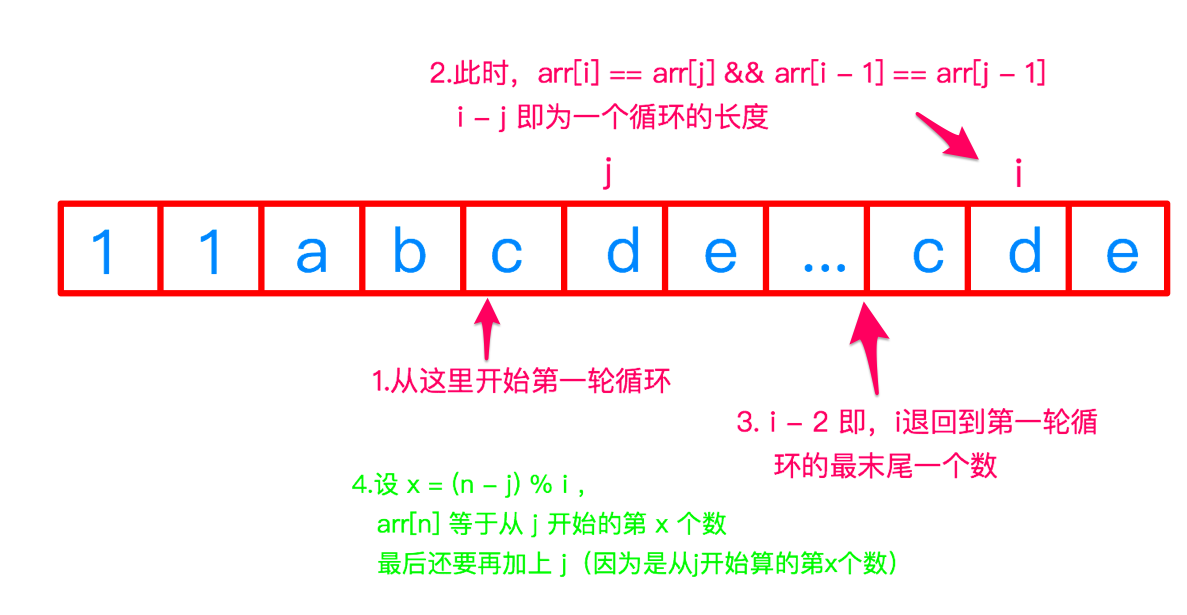ACM | HDU 1005 Number Sequence
HDU 1005 Number Sequence
Time Limit: 2000/1000 MS (Java/Others) Memory Limit: 65536/32768 K (Java/Others)
Total Submission(s): 195570 Accepted Submission(s): 49019
Problem Description
A number sequence is defined as follows:
f(1) = 1, f(2) = 1, f(n) = (A * f(n - 1) + B * f(n - 2)) mod 7.
Given A, B, and n, you are to calculate the value of f(n).
Input
The input consists of multiple test cases. Each test case contains 3 integers A, B and n on a single line (1 <= A, B <= 1000, 1 <= n <= 100,000,000). Three zeros signal the end of input and this test case is not to be processed.
Output
For each test case, print the value of f(n) on a single line.
Sample Input
1 1 3
1 2 10
0 0 0
Sample Output
2
5
这道题...好忧伤啊...做的时候根本没在意,感觉就是一个大循环,前面的数模 7 以后结果可能是 0-6,第二个数也是 0-6,所以有 7 * 7 = 49 种可能,就直接觉得一次循环就是49了...最坑的是杭电这道题的测试数据特别水,居然让我给过了 TAT...
然后给学校网站出题的时候直接用了这道题,提交了一些但是没有人对...有同学给我说可能数据错了...然后我才发现我的做法本身就有问题 TAT...
下面是我目前觉得应该是正确的代码...看不懂的话最后面有图解...如果还是错了的话..希望能有人给我说...虽然..咳咳..应该没人会看的吧TAT
#include <iostream>
#include <cstdio>
using namespace std;
int arr[100] = {0, 1, 1};
int main(int argc, const char * argv[]) {
int a = 0, b = 0, n = 0;
while (~scanf("%d%d%d", &a, &b, &n)
&& (a + b + n)) {
// 查找一次循环的个数
int flag = 0;
int i = 3, j = 2;
for (; i <= n; ++i) {
arr[i] = (a * arr[i - 1] + b * arr[i - 2]) % 7;
// 从前面找起,若有两个连续的数完全相同,则开始循环
// 不用因为两层循环而担心时间的问题,因为这个循环次数特别少
for (j = 2; j < i; ++j) {
if (arr[i] == arr[j] && arr[i - 1] == arr[j - 1]) {
flag = 1;
break;
}
}
if (flag) break;
}
// 当循环结束时,i - 2 ,去掉了最后两个重复的数
if (n > j) {
arr[0] = arr[i - 2];
// i - j 去掉了开头一部分可能没有被循环起来的数
i -= j;
// (n - j) % i 后结果为,查看又循环到了第几个数
// 但是别忘记,再加上 j ,因为还有开头的数得再加上
cout << arr[(n - j) % i + j] << endl;
} else {
cout << arr[n] << endl;
}
}
return 0;
}
图解:
emmmm...感觉和网上的做法也不太一样...虽然我也没太仔细看网上的做法..然后自己想了下,觉得这么做可能对的吧.....
哈哈哈哈哈哈
